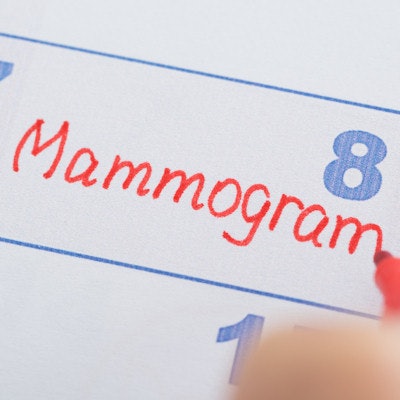
Could a breast cancer screening protocol based solely on a woman's risk factors -- rather than her age as is currently the norm with population-based screening -- result in delayed detection for many women? Yes, according to a study published in the January issue of the American Journal of Roentgenology.
The findings suggest that a risk-based approach to screening, considered by some to be useful for alleviating the so-called harms of mammography and reducing healthcare costs, could be dangerous for many women at average risk of breast cancer, wrote a team led by Dr. Colleen Neal from the University of Michigan.
"[Risk-based] models prioritize mammographic screening for women who are at higher risk for breast cancer because of factors such as family history and dense breast tissue and propose delayed screening initiation or less frequent screening for women at average risk," the group wrote. "However, many women who do not have dense breast tissue or family history are diagnosed with breast cancer. Therefore, prioritizing screening efforts for women with [these] risk factors ... could negatively impact the mortality and morbidity reduction benefit of screening mammography for many average-risk women."
Evaluating risk
In the ongoing battle over mammography screening, risk-based protocols have been proposed as a way to maximize healthcare resources by directing screening to women who are most likely to have breast cancer, based on factors such as family history or dense breast tissue. Women with fewer risk factors might undergo screening less often under this approach.
Most advocates of risk-based screening propose its use for women ages 40 to 49, for whom some argue that mammography is least effective. But others have suggested that risk-based screening could also be used for older women: For example, a 2016 Annals of Internal Medicine paper by Trentham-Dietz et al suggested screening every three years for average-risk women with low breast density.
However, breast cancer still occurs in women who don't have risk factors such as dense breast tissue or a family history of cancer. Therefore, in the current study, Neal's group sought to investigate if a risk-based mammography screening protocol would miss cancers that population-based screening would detect (AJR, January 2018, Vol. 210:1, pp. 228-234).
The researchers identified 552 breast cancers detected at screening between January 2011 and December 2014 in 533 patients, and they reviewed each patient's medical record for pathology, cancer size, nodal status, breast density, and mammographic findings. The breast cancer risks evaluated by Neal and colleagues were whether patients had a family history of breast cancer (first-degree relative with breast cancer) and whether their breast tissue was heterogeneously or extremely dense.
The researchers divided the study participants into three groups to see how often cancers occurred in women not typically considered to be high-risk:
- Group 1 -- Patients who did not have a personal history of breast cancer (409 of 533, or 76.7%). This group was considered to be typical of a population with average cancer risk.
- Group 2 -- Patients who were between the ages of 40 and 49 (89 of 533, or 16.7%). This group was designed to examine the question of whether risk-based screening is suitable for younger women.
- Group 3 -- All study participants. This group was created to enable the researchers to calculate the overall number of breast cancers by each risk factor.
Of all the cancers detected at screening, 34.6% were ductal carcinoma in situ (DCIS) and 65.4% were invasive, with a median size of 11 mm, Neal and colleagues found.
Most importantly, cancers were identified in many women without risk factors, they noted.
"We found screen-detected breast cancers in many women without risk factors of family history or dense breast parenchyma," the group wrote.
For example, among the cancer patients in group 1 -- those considered to be at average risk under a risk-based protocol -- 75.6% had no family history of breast cancer and 56% had nondense breasts.
Meanwhile, in group 2 -- women ages 40 to 49, who some have suggested might be the best-suited for risk-based screening -- 79.8% had no family history of breast cancer and 30.3% had nondense breasts.
When the researchers considered all women (group 3), they found that 72.8% of those with screen-detected breast cancer had no family history of the disease, 76.7% had no personal history or high-risk lesion, and 59.5% had nondense breast tissue. About a third of the total number of women included in the study had all three of these risk factors.
| Risk factor rates in women with screen-detected cancer | |||
| Risk factor | Group 1: Average-risk patients | Group 2: Patients 40-49 | Group 3: All patients |
| Personal history: No prior biopsy | 78% | 70.8% | 59.8% |
| No 1st-degree relative with breast cancer | 75.6% | 79.8% | 72.8% |
| Density | |||
| Fatty | 9% | 4.5% | 9.4% |
| Scattered fibroglandular | 46.9% | 25.8% | 50.1% |
| Heterogeneously dense | 40.3% | 59.6% | 37.5% |
| Extremely dense | 3.7% | 10.1% | 3% |
What's the bottom line? Basing the decision of whether or not to screen solely on risk factors could lead to many missed cancers.
"A risk-based breast cancer screening strategy that prioritizes screening mammography for patients with [these factors] could have resulted in a delayed diagnosis of breast cancer for many patients."
Which is better?
Having a family history of breast cancer and dense tissue do increase a woman's risk of the disease, but not all women with these risk factors develop breast cancer, and many women without these risk factors do, Neal and colleagues wrote.
Population-based models may have low predictive value for individuals, but risk-based screening may not be worth the gamble of missed cancer in average-risk women.
"All women are at risk for breast cancer," they wrote. "Delaying initiation or decreasing the frequency of breast cancer screening for average-risk women could ... sacrifice an important mortality reduction benefit."



















